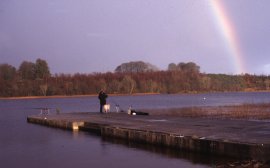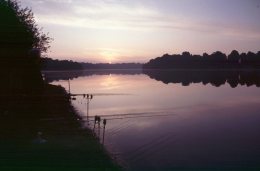Every now and then, though not too often these days, we come across a new water, new that is, in that it has just been opened to anglers. It could be that it is an estate lake and the estate is feeling the pinch like the rest of us and is, therefore, glad of the extra bob or two that anglers fees provide.  It could simply be that the lake has changed hands and the new owners have a different attitude. Whatever the reason, occasionally we get the opportunity to fish a new water, a water that has not been fished on a regular basis before, where information about the species present, the general size of them, and the whereabouts of the productive swims, is hard to come by, to say the least. And when that happens the first thing we ask ourselves is, ‘where do we start?’
It could simply be that the lake has changed hands and the new owners have a different attitude. Whatever the reason, occasionally we get the opportunity to fish a new water, a water that has not been fished on a regular basis before, where information about the species present, the general size of them, and the whereabouts of the productive swims, is hard to come by, to say the least. And when that happens the first thing we ask ourselves is, ‘where do we start?’
The bigger the lake, the bigger the problem, and to any angler who has not been faced with this kind of problem before, it can be rather daunting. But more important, it can also be the source of a hell of a lot of pleasure, for if the task is approached in the right kind of way the rewards can be tremendous, far outweighing any other consideration. The feeling of satisfaction when that first fish slides into the net is difficult to describe.
The one outstanding factor that makes it all the more exciting is if there is very little known about the water. One thing is certain; rumour will be rife! There will be a few people about somewhere who will have fished it, perhaps by poaching, or maybe they had permission to fish it occasionally. Stories of big fish will be rife, for no matter what the real truth is, human nature will embroider the stories as they are passed from mouth to mouth. It’s great! It gets us all excited, for no matter how hard we try to take the stories with a large pinch of salt the optimist that lurks somewhere in even the most pessimistic of us clings to the hope that there is a large grain of truth in what we hear. Right, where do we start?
The first thing I do, mentally at least, is sort out a list of certainties, possibles and probables. For instance, there are some things we can say pretty definitely, such as the species that are certain to be in the water, for if the water is, say, a Cheshire mere, we can safely say there will be bream, tench, pike and eels present. There will probably be roach, rudd and perch. Possibly, there will be carp, crucian carp, roach x bream, rudd x bream, and roach x rudd hybrids. How big any of these fish grow to will be the greatest unknown quantity, for it is here where the rumours will have bred and multiplied!
I follow up by doing the most obvious thing: take a slow stroll around the water, soak up the atmosphere, and see what kind of feeling I get about the place. I’ve found over the years that my first impressions of a water are usually right. Okay, they are only impressions, but as far as I’m concerned they set the scene. Although, if I get negative feelings they don’t prevent me from going on to check the place out to establish some hard facts. During the walk I look out for fish at the surface, or in the shallows, or merely signs of fish. I take in the type of bottom at the margins, the vegetation there, where there are overhanging trees, islands, and generally the lie of the land, which is usually a good indicator of depth and overall bottom shape. But mainly, this first, slow walk around the water simply gives me a feel for the place.
The next job is to do a more detailed study; plumb the depths and chart these and the features on a map of the water; drag a bomb around to find possible snags; and drag a rake through here and there to see what comes out.
If you haven’t got one of your own, try to beg, borrow or steal a sonar device. They provide the easiest, quickest and most accurate method of charting the bottom. If boats are not allowed, or you can’t get hold of a sonar, then you will have to do it the hard way, with float and plummet and timed bomb drop. 
The first thing to do though, is make an enlarged photocopy of the appropriate section of an Ordnance Survey map, then, if necessary, photocopy again at a greater enlargement until you have just the water covering the paper. A chart at A3 size is large enough to contain sufficient detail, and small enough to handle in a boat. Now add the relevant landmarks and other details; rushes, trees, bushes, emergent plant life, etc, etc, and draw lines across the water from one landmark to another. These are the lines you will follow with the boat, marking the depths and features on the chart as you go. Obviously, the more detail you want the more lines you will draw across the chart, joining up a landmark on one bank to several other landmarks on other banks. Distance is the most difficult thing to judge. Estimating the distance from a boat to the bank can be a different proposition than estimating that same distance from bank to boat. Ask anyone who has gone out on a boat to place a marker. It is quite common to place it much further than you intended.
Even with a sonar, it still takes quite some time to fully cover a large water, and is best done over a period of several days, spread over as long a period that suits you, sounding one area at a time. Whilst in the process of charting you will be choosing swims based on the information you see, only later studying the chart, revising what you’ve learned, and making more considered decisions.
Right, we’ve charted the water, chosen a likely swim for the species we hope to catch – what next?
A prebaiting campaign is the obvious answer, followed by a period of fish-spotting running alongside the actual fishing. Which means that we prebait the swim we’ve chosen, based on the information provided by the sonar and observation, every other day for a period of a week – longer if possible – then fish the swim whilst watching the water carefully for signs of fish. This way we have an iron in the fire in the shape of at least two rods doing the fishing, and another iron in the shape of observation, both of which will provide information on which to base a judgement about whether to move or stick it out in the swim we’re fishing.
If, we do happen to spot fish moving in an area other than the one we’re fishing, even if we are enjoying some kind of result in the baited swim, we could then begin to prebait the other swim for several days at least, and then give it a try for a spell. And then, perhaps be able to keep our eye on another area of the lake, with a view to prebaiting that for while, and so on, until we have some idea about which is the best general area, and, indeed, the location of any hot-spots within that area.
Of course, what I’m saying doesn’t happen overnight. It may take two or three seasons, or more, to gather sufficient information (experience) to get the best out of the water. What we have to bear in mind is the fact that there will be different criteria for different times of the year, and certainly for different species – assuming we intend to fish the water for more than one species. There will be a degree of overlap with some species, such as carp, bream, tench and roach, where at certain times they will share the same swim at the same time, but when it comes to ceasing, say, fishing for bream, and beginning to fish for pike, then it is a different ball game altogether, and we have to start collecting, collating, and sifting through information all over again.
But as far as I’m concerned that simply means that the best part of fishing starts all over again. A new challenge to meet head on, a new set of problems to overcome and, very probably, another period of purposeful fishing to draw intense satisfaction and enjoyment from. I can’t think of anything better. And I mean anything!










